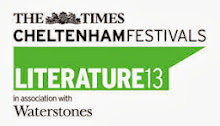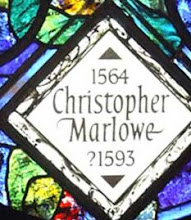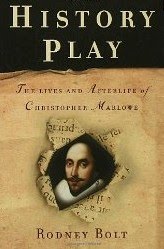 The Earl of Oxford is known to have died in 1604, when according to virtually all Shakespearean scholars at least a quarter of Shakespeare's plays were yet to be written. Oxfordians - who unlike Marlovians generally accept the date upon which their candidate is supposed to have died - imagine that they can overcome this problem by claiming that these plays must have all been written before then, and that the scholars have simply shifted them into the period c.1592-1613 because that corresponds with what would have been the writing career of their author, William Shakespeare of Stratford. Oxfordian chronologies would have him writing everything some ten or more years earlier.
The Earl of Oxford is known to have died in 1604, when according to virtually all Shakespearean scholars at least a quarter of Shakespeare's plays were yet to be written. Oxfordians - who unlike Marlovians generally accept the date upon which their candidate is supposed to have died - imagine that they can overcome this problem by claiming that these plays must have all been written before then, and that the scholars have simply shifted them into the period c.1592-1613 because that corresponds with what would have been the writing career of their author, William Shakespeare of Stratford. Oxfordian chronologies would have him writing everything some ten or more years earlier. Unfortunately for them, however, it is not quite as simple as that. How much the blank verse used in English drama changed over the years cannot simply be ignored in this way. Let us look at one such change - the gradual but steady move away from a procession of end-stopped lines in regular iambic pentameter.
The opposite of an end-stopped line, an open line - or a run-on line, or enjambment - is one in which the meaning flows on to the next line without punctuation. For example, see Prospero's famous lines in Act IV scene 1 of The Tempest:
Our revels now are ended: these our actors,It would simply not be possible to put any sort of punctuation at the end of the second line without wrecking the sense. That's an open line. And a feminine ending? The rhythm of Shakespeare's blank verse is the iambic (di-dum) pentameter (repeated 5 times). This is how lines two and three scan, but not line one, which has acquired an extra "di" syllable at the end. That's a feminine ending.
As I foretold you, were all spirits, and
Are melted into air, into thin air.
In a post to SHAKSPER ("The Global Electronic Shakespeare Conference") on March 2, 1996, David Kathman wrote: "The use of feminine endings in blank verse increased steadily among English poets in general between the 1580s and the 1620s, just as the use of enjambment increased steadily in the same period; Shakespeare followed both of these trends"; and as Ward Elliott and Robert Valenza tell us: "The percentages of both indicators tripled over Shakespeare's lifetime."1
Here, using Elliott and Valenza's figures, are details of plays by Beaumont, Chapman, Daniel, Dekker, Fletcher, Greene, Heywood, Jonson, Kyd, Herbert (Mary), Lyly (that lone one at the bottom), Marlowe, Middleton, Munday, Nashe, Peele and Porter.2
 As we can see, even though the data come from many different playwrights, there is a clearly discernable trend, as indicated by the computer-generated trendline. Note in particular that before 1600 only two plays exceeded a usage rate of 35, whereas after 1600 only two plays did not exceed that level. By "usage rate," we mean the number of open lines plus feminine endings there are on average per hundred lines of verse.
As we can see, even though the data come from many different playwrights, there is a clearly discernable trend, as indicated by the computer-generated trendline. Note in particular that before 1600 only two plays exceeded a usage rate of 35, whereas after 1600 only two plays did not exceed that level. By "usage rate," we mean the number of open lines plus feminine endings there are on average per hundred lines of verse.Although there is no generally agreed chronology for the works of Shakespeare, the differences between the dates suggested by various scholars are relatively minor. Given that the figures being used in these graphs are those of Elliott and Valenza, it seems appropriate to use their dates too.
Here is a graph in which the usage rate for each Shakespeare play according to Elliott and Valenza is plotted against the date they suggest for it. It is worth bearing in mind that their intention in assembling this information had nothing to do with our reason for using it here.
 Even without the trendline, one can see how Shakespeare's figures increase over the years as David Kathman reported - in fact at a quite extraordinarily constant rate. What should be pointed out is that every one of the plays usually given a date after the death of the Earl of Oxford in 1604 has a usage rate greater than 45. Every other Shakespeare play (i.e. 1604 or earlier) except Measure for Measure (50) and All's Well That Ends Well (51) has a rate of less than that.
Even without the trendline, one can see how Shakespeare's figures increase over the years as David Kathman reported - in fact at a quite extraordinarily constant rate. What should be pointed out is that every one of the plays usually given a date after the death of the Earl of Oxford in 1604 has a usage rate greater than 45. Every other Shakespeare play (i.e. 1604 or earlier) except Measure for Measure (50) and All's Well That Ends Well (51) has a rate of less than that. Although these dates are the ones given by Elliott and Valenza, the trend would have been no less evident if we had used the dates published by any other Shakespearean scholar. No matter which of the various orthodox chronologies one chooses, there is a highly significant trend by which these figures increase over the years. In other words we can be very confident that most if not all of those plays given a date after the death of the Earl of Oxford were indeed written after those given a date before it.
Some Oxfordians argue that the whole timetable could be moved back ten years or so, which would result in precisely the same trend in Shakespeare's works, and simply mean that the other writers took longer than we thought to catch on to the changing approach. Unfortunately for this argument, however, it would mean them bumping straight into the buffer which is Francis Meres.
In 1598 Francis Meres published his Palladis Tamia which, had it not been for its relevance to Shakespeare, might have been largely forgotten long before now. In this he gave a list of plays by Shakespeare, which clearly indicated that they must have been performed by that year. He said that Shakespeare was the "most excellent" English dramatist for both comedy and tragedy, and gave as examples of the former The Two Gentlemen of Verona, The Comedy of Errors, Love's Labour's Lost, A Midsummer Night's Dream, The Merchant of Venice and the now untraceable Love's Labour's Won. For tragedy he cited Richard II, Richard III, Henry IV, King John, Titus Andronicus, and Romeo and Juliet.
As Oxfordians are quick to point out, however, it's not a complete list of the plays Shakespeare had written by then, since it is fairly clear that the three parts of Henry VI and The Taming of the Shrew - although not necessarily with the same titles - had also been performed before 1598. So is there a specific reason for those plays to have been omitted which would not apply to any other? Yes, there certainly is.
This is what Edward Burns says in his Arden (3rd series) edition of 1 Henry VI (p.8), describing the first page of the theatre owner Philip Henslowe's accounts: "What follows is a day-to-day calendar of the plays performed that year at the Rose theatre by a company under the patronage of Lord Strange - hence 'my lord stranges mene'. About a third of the way down the page a line reads 'ne - Rd at harey the vj the 3 of marche 1591...iijli xvjs 8d'." "Harey the vj" is generally accepted as being 1 Henry VI, and there is no record of it ever being performed by any company other than Lord Strange's Men.
In his Arden 3 edition of 2 Henry VI (p.121), Ronald Knowles says: "...it seems probable that, by 1591, 2 and 3 Henry VI had been performed successfully, presumably by Lord Strange's company, since 'Pembroke's Men' appears on the title page of The True Tragedy [the 1595 quarto of 3 Henry VI] and this company is generally considered an offshoot of Strange's." 2 Henry VI had been called "The First Part of the Contention between the two great houses of York and Lancaster." That it was the "first part" may be taken to indicate that both plays were owned and performed by the same company.
All three of the Henry VI plays therefore seem to have been the property of the Strange/Pembroke companies and there is no record of their being associated in any way with the Lord Chamberlain's company. The reason for their omission from Meres's list is therefore fairly clear - he didn't know that they were by Shakespeare, resident playwright for the Lord Chamberlain's Men.
Similarly, The Taming of the Shrew had a quarto version called The Taming of A Shrew and, as Brian Morris (Arden 2, p.45) says, its title-page states, "As it was sundry times acted by the Right honorable, the Earle of Pembroke his servants." The next time we hear of it is in the First Folio of 1623.
Titus Andronicus was similar to this, although Meres did include it in his list. What we find in this case, however - despite evidence of it having passed through the hands of Strange's, Pembroke's and even Sussex's Men - is that when Q2 appeared in 1600 (only two years after Meres's list) it had added the Lord Chamberlain to the noblemen whose servants had played it, most probably before 1598.
There is no evidence of any of the rest of the plays on Meres's list having been played by companies other than the Lord Chamberlain's. It's been suggested that Richard III might have originated with the Strange/Pembroke group, but the fact that the 1598 quarto is ascribed to Shakespeare - and that there was a bawdy 1602 joke about Burbage playing Richard - makes it fairly certain that it was in the Lord Chamberlain's Men's repertoire by the time Meres mentioned it.
So Meres's list seems to consist only of those plays said to have been by Shakespeare which were in the Lord Chamberlain's Men's repertory by 1598. Most scholars therefore quite reasonably claim that the first plays written by Shakespeare were those Meres listed, plus the other four, and that any other plays of his made their first appearance after this date.
In considering whether this claim is justified it is interesting to see how much the two techniques are used in those first 15 plays of Shakespeare - the 11 on Meres's list for which we have data plus the four missing ones - when compared with the rest of his plays. If we do so we find that (with the exception of 1 Henry IV and The Merchant of Venice) every one of them has a usage rate lower than 35. In contrast, every other play of his (with the exception of The Merry Wives of Windsor which has hardly any verse to speak of) has a rate exceeding 35. This offers massive support for the Shakespearean scholars' claim.
That this matches the trend observed among Shakespeare's contemporaries is reinforced by the fact that in the first graph the contemporaries' trendline is only two points away from his level in 1598. By 1604, however, he is ahead by some ten points on average, and by 1613 that difference between them has grown to twenty per hundred lines of verse. Part of what made Shakespeare's verse so much greater than the rest was this appreciation of just how much freedom the two techniques offered.
To sum up:
1) Whether we are talking about Elizabethan or Jacobean playwrights in general or about Shakespeare in particular, there is a very clear trend in which the use of open lines and feminine endings tended to increase throughout Shakespeare's lifetime.
2) All of the orthodox Shakespearean chronologies show ten or eleven plays written after Oxford's death.
3) Every one of the eleven plays considered here has a frequency of open lines plus feminine endings which is more than that of any other play ascribed to Shakespeare bar two. The median (midpoint) value of the figures for these plays is 64 per hundred lines of verse.
4) Of the plays listed by Francis Meres as having been written by 1598 - plus those missing from his list for which there is evidence of earlier performance by the Strange/Pembroke companies - every one of them other than The Merchant of Venice and 1 Henry IV has a frequency of open lines plus feminine endings which is less than any of the rest of the plays attributed to him other than The Merry Wives of Windsor. The median value for all of them is only 26 per hundred lines of verse.
5) No matter which of the various orthodox chronologies one chooses, there is a highly significant trend by which these figures increase over the years. However, as the reasoning explained in Gary Taylor's chronology shows,3 the high correlation of the figures with the dates is not due to the latter being based upon the former, which plays little or no part in how the dates are arrived at. So the clear trend adds considerable support to the orthodox datings being substantially correct.
6) This leaves Oxfordians with the following options.
• Find reasons for shifting every one of those ten or eleven plays back before 1604, and pretend that the resulting demolition of the trend doesn't matter.
• Shift the whole canon back the requisite amount in time, which would retain the trend, but then explain why Meres had inexplicably omitted most of Shakespeare's finest plays from his list.
• Create an entirely new chronology for the post-1598 plays which retains the trend, but squeezes all 23 of them into the six-year period between 1598 and 1604. Without any justification for the "new" dates being based either upon internal or external evidence, however, this would of course be cheating.
• Hope that nobody notices and that it will all just go away, or
• Think it possible that they just might be backing the wrong candidate?
Peter Farey
© Peter Farey, September 2009
Emmerich Anonymous Shakespeare
Peter Farey, a founding member of the International Marlowe-Shakespeare Society, is the 2007 recipient of the Calvin & Rose G. Hoffman Prize, administered annually by The King's School in Canterbury for a "distinguished publication on Christopher Marlowe." He was also a founding member (with Derek Jacobi) of the UK's National Youth Theatre. Click here to reach Peter's website.
Are Oxfordians backing the wrong candidate? Click here for Peter's fascinating analysis of how Marlowe compares with de Vere on Shakespeare authorship criteria.
1Elliott, Ward and Robert Valenza. "And Then There Were None: Winnowing the Shakespeare Claimants." Computers and the Humanities 30, 1996. p.198.
2Ibid. pp.211-211. All of their counting was done by computer, and the authors acknowledge (p.215) that it is not as accurate as manual counting for feminine endings. For the present exercise, however, this is of less importance than having the same method used throughout.
3Taylor, Gary. "The Canon and Chronology of Shakespeare's Plays," in Stanley Wells, Gary Taylor et. al., William Shakespeare, A Textual Companion (1987, 1997). pp.81-2.
Click here for the blog's home page and recent content.

















